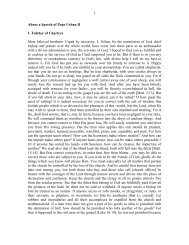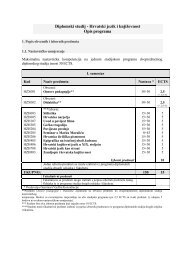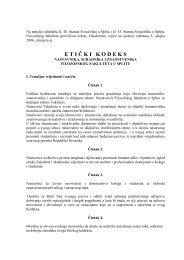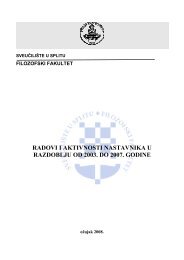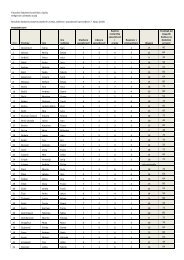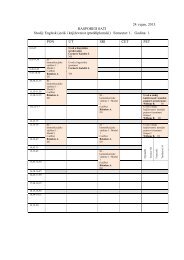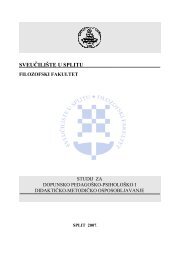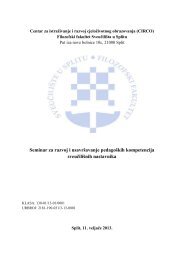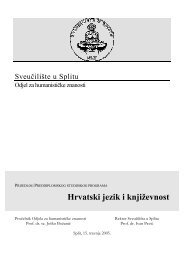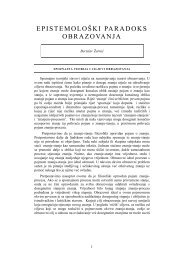English Studies
English Studies
English Studies
Create successful ePaper yourself
Turn your PDF publications into a flip-book with our unique Google optimized e-Paper software.
G R A D U A T E D E G R E E P R O G R A M M E : E N G L I S H S T U D I E S<br />
repetition.<br />
Course title <strong>English</strong> syntax – comparative and formal aspects<br />
Course code HZE604<br />
Type of course Lecture + Seminar / Advisory hours<br />
Elective course<br />
Level of course<br />
Intermediate level course<br />
Year of study First Semester One<br />
ECTS<br />
(Number of<br />
credits allocated)<br />
Name of lecturer<br />
Learning<br />
outcomes and<br />
competences<br />
Prerequisites<br />
Course contents<br />
Recommended<br />
reading<br />
Supplementary<br />
reading<br />
Teaching<br />
3 ECTS<br />
Contact hours (15 lectures + 10 seminars + 5 advisory hours) = 0.75 credits.<br />
Student study time (67.5 hours) = 2.25 credits.<br />
Dr Adelija Čulić Viskota, senior lecturer<br />
After the completion of the course, the student is expected to understand<br />
<strong>English</strong> syntax, the basic word order restrictions, and the fundamental<br />
differences between Croatian and <strong>English</strong> syntax. The student should be<br />
able to analyse <strong>English</strong> and Croatian sentence structure in various<br />
theoretical frameworks. S/he is also expected to have developed the ability<br />
to apply the knowledge of syntax to the solution of various practical<br />
problems related to second language acquisition, language typology,<br />
translation theory and computability of natural language syntax.<br />
Competences and skills acquired upon the completion of undergraduate<br />
(BA) degree programme in <strong>English</strong> <strong>Studies</strong> or a similar programme.<br />
This course introduces the syntactic regularities found in <strong>English</strong> and<br />
fundamental linguistic strategies, instruments and models to describe and<br />
analyse them. This course is both, descriptive, data-driven and theoretical,<br />
focusing on real data found in tree banks and corpora, as well as on<br />
theoretical aspects of word order regularities. One important aspect lies on<br />
the typological differences between <strong>English</strong> and Croatian syntax.<br />
1. Free online book:<br />
Santorini, B., i Kroch, A. (2000). The syntax of natural language: An online<br />
introduction using the Trees program.<br />
http://www.ling.upenn.edu/~beatrice/syntaxtextbook/index.html<br />
2.Radford,A. (1999). Syntax: A Minimalist Introduction. CUP<br />
3. Carnie, A. (2003) Syntax: A Generative Introduction. Blackwell Publ.<br />
Ltd.<br />
Baltin, M. & Collins, C. (2003) The Handbook of Contemporary Syntactic<br />
Theory. Blackwell Handbooks in Linguistics<br />
Lectures (student-participation-encouraged / on-line) / Seminars<br />
(discussion, seminar papers, reports, etc.) / Distance Learning / Advisory<br />
17



